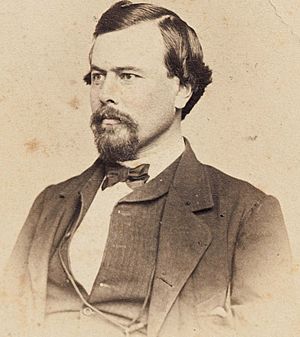Stephen H. Weed facts for kids
Quick facts for kids
Stephen Hinsdale Weed
|
|
|---|---|
 |
|
| Born | November 17, 1831 Potsdam, New York |
| Died | July 2, 1863 (aged 31) Gettysburg, Pennsylvania |
| Place of burial |
Moravian Cemetery, New Dorp, Staten Island, New York
|
| Allegiance | United States of America Union |
| Service/ |
United States Army Union Army |
| Years of service | 1854–1863 |
| Rank | |
| Commands held | 5th U.S. Light Artillery, Battery I |
| Battles/wars | American Civil War † |
| Signature | |
Stephen Hinsdale Weed (born November 17, 1831 – died July 2, 1863) was a brave military officer in the United States Army. He is remembered for his courage during the American Civil War. He was killed while defending a very important hill called Little Round Top during the Battle of Gettysburg.
Contents
Stephen Weed's Early Life and Military Start
Weed was born in Potsdam, New York, as the second of four children. His parents were John Kilbourne and Charity Winslow Weed.
Joining the Army and Frontier Adventures
Stephen Weed attended the United States Military Academy at West Point. He graduated in 1854, ranking 27th in his class of 46 students. Many of his classmates also became famous generals during the Civil War.
After graduating, he became a second lieutenant. He started his military career serving in Texas. Later, he was promoted to first lieutenant. He fought in Florida during the Seminole Wars in 1856 and 1857.
Weed also helped calm down problems in Bleeding Kansas in 1858. He commanded a group of soldiers called Battery B, 4th U.S. Artillery. He helped bring order to the Utah Territory during the Utah War. He also fought against Native American tribes in battles like Battle of Egan Station and Battle of Deep Creek in 1860.
Stephen Weed in the Civil War
When the Civil War began, Weed was promoted to captain in May 1861. He led a new artillery unit called Battery I, 5th U.S. Artillery. He spent time training his soldiers in Harrisburg, Pennsylvania.
Leading Artillery Units
In 1862, his unit joined the fighting in the Peninsula Campaign. They also fought at the Second Battle of Bull Run. Captain Weed led his battery during a big cannon fight at the Battle of Antietam.
Later, he was put in charge of all the cannons for the V Corps. His cannons were used in the Battle of Fredericksburg. He also took part in the Battle of Chancellorsville. On June 6, 1863, Stephen Weed became a brigadier general. He was given command of a brigade, which is a large group of soldiers.
The Battle of Gettysburg and Little Round Top
At the Battle of Gettysburg, General Weed's brigade was sent to help defend Little Round Top. This hill was very important for the Union army. His soldiers arrived just in time to stop a Confederate attack that was trying to go around the side of the Union lines.
During this intense fighting, General Weed was badly wounded in the chest. This happened while he was standing near his cannons on the hill. Some say he was shot by a very accurate shooter hiding nearby. His last reported words were, "I would rather die here than that the rebels should gain an inch of this ground." Another officer, Lt. Charles E. Hazlett, was killed trying to hear what Weed was saying. After General Weed was wounded, Colonel Kenner Garrard took command of the brigade.
A Young Girl's Memory
A young girl named Tillie Pierce lived in Gettysburg and saw parts of the battle. She remembered General Weed. He was brought to her family's farm, which was being used as a hospital. Tillie briefly watched over him. She asked if she could do anything for him.
General Weed asked her to promise to come back and see him the next morning. She promised she would. The next day, Tillie went back to the room. She found that General Weed had died during the night. His loyal helper was still by his side. The helper told Tillie that the man was General Weed, from New York.
General Weed's body was taken home. He was buried in the Moravian Cemetery in New Dorp, a village on Staten Island, New York.
Remembering Stephen Weed
People remembered Stephen Weed for his bravery. In September 1863, a military defense area near Washington, D.C. was renamed "Fort Weed" in his honor.
After the war, a group of veterans in New York City named their post the Stephen H. Weed Post. In 1902, a part of Fort Wadsworth in New York Harbor was renamed Battery Weed. In 1930, a street in New Dorp Beach, Staten Island, was named Weed Avenue to honor him.

